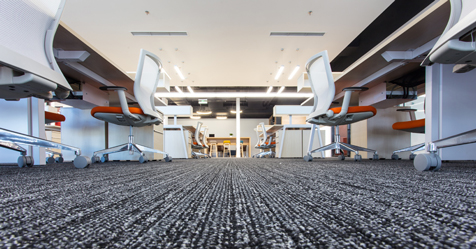Editor’s note:
The following letter to the editor was received from Geoff Greeley, vice president of market development and support for Racine Industries Inc., after a recent “Ask the Experts” post on the CM e-News Daily® that discussed the differences in cleaning carpet versus tile and why — if at all — one is preferable to the other.
The recent post, “Ask the Experts: Carpet versus tile,” was an interesting exploration of an age-old question: Carpet or tile?
While there are very good reasons for installing carpet and equally good ones for tile, we think some key points were missed in the discussion.
One opinion stated, “I prefer hard surfaces and believe that they are easier and less expensive to maintain than carpet or soft floor coverings.”
The writer went on to say that efforts by the carpet industry to “support their position that carpeting is less expensive to purchase, install and maintain” was based on “biased and flawed marketing studies.”
We are aware of a landmark study that was managed by a carpet end-user with a great deal at stake; including, but not limited to, budget, life cycle costs, indoor air quality (IAQ) and the general health and welfare of the people within the facilities.
This study was not commissioned by the carpet industry, nor was it paid for by manufacturers of cleaning and maintenance equipment.
The conclusions were published in a poster presentation for the American Association of Textile Chemists and Colorists (AATCC) Convention in 2009 and summarized the experience of the Pasco County School System as they evaluated different methods for carpet maintenance and vinyl composite tile (VCT) maintenance in several school buildings over a year”s time.
Their meticulously documented conclusions showed an overall cost savings of 55 percent compared to VCT maintenance and a 53 percent cost savings over traditional wet extraction cleaning and maintenance practices.
Your expert also mentioned that: “The current trend today is away from carpeting — sales are off 20 percent to 40 percent.”
The Carpet and Rug Institute (CRI) did a survey several years ago that asked why consumers were “deselecting” carpet.
The number one reason given was “cleaning and maintenance issues.”
Many things drive this opinion, but it is clear that proper, scheduled and planned carpet maintenance is lacking in commercial facilities.
The Pasco County School System study shows that, when properly managed, carpet can be maintained at a relatively low cost and deliver on its promised life expectancy.
The question of disinfecting carpet was also mentioned in that carpet cannot be disinfected reliably.
However, carpet inherently provides the unique benefit of trapping and holding the soil, dust, contaminants and allergens that enter and descend onto the floor.
These soils, dusts and allergens get tracked inside on shoe soles — and they come into the indoor environment through the air.
It is the vertical-pile construction of carpet that makes the floor covering unique in its ability to act as a filter for air.
This filter holds these biologicals and effective cleaning removes them.
Studies show that carpet does not release these biologicals into the air; they remain in the carpet until removed by cleaning.
As with all cleanable filters, the allergens, soils and dusts that carpet holds can be easily removed.
In fact, efficient and effective cleaning and care of carpet is assuming even greater importance in managing the indoor environment.
The reason? As the load of soils, dusts and allergens increases on and in a carpet, the efficiency of that carpet to continue to trap, filter and hold decreases.
Weekly vacuuming and pile lifting along with a strategic maintenance plan keep the carpet clean and healthful.
While a carpet cannot be disinfected, its ability to trap and hold impurities that come into contact with it makes it the perfect filter.
It holds these impurities until vacuuming, pile lifting and periodic cleaning removes them.
This provides a clean surface that will continue to trap and hold the everyday dust and dirt that comes into a building.


